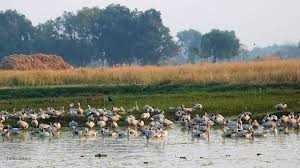
The Department of Wildlife Protection, in collaboration with the Wular Conservation and Management Authority (WUCMA), is set to conduct the Asian Waterbird Census (AWC) 2025 on Wednesday (February 19).
This annual initiative plays a crucial role in estimating the population of migratory birds visiting Kashmir’s wetlands and assessing the ecological health of these vital habitats.
Rashid Yahya Naqash, Regional Wildlife Warden said the migratory birds start arriving in Kashmir’s wetlands between November and March.
He highlighted the Central Asian Flyway, a significant migration route used by birds traveling from Russia, Siberia, Europe, and China, and stressed the importance of Kashmir’s wetlands as crucial stopover points.
Tawheed Ahmad Deva, Regional Wildlife Warden, Kashmir, emphasized that the census is a key scientific exercise, as bird migration serves as an essential indicator of wetland health.
He also noted that over the past two years, more than 12 lakh migratory birds have been recorded in Kashmir’s wetlands, reaffirming their global ecological importance.
Altaf Hussain, Wildlife Warden, Wetlands Kashmir, and Coordinator of Wular Conservation and Management Authority (WUCMA), expressed satisfaction that most of Kashmir’s major wetlands currently hold sufficient water levels to sustain migratory birds.
He highlighted that interventions such as the construction of regulatory gates at Hokersar, in collaboration with the Irrigation and Flood Control Department, have significantly improved water retention in the Hokersar wetland.
He further noted that Hokersar’s water levels are now higher than they have been in the past decade, ensuring a more stable and suitable habitat for migratory birds.
The Asian Waterbird Census 2025 will cover 25 key wetlands, including four Ramsar sites—Hokersar, Haigam, Shallabugh, and Wular Lake—each serving as a critical habitat for thousands of migratory birds.
The census will be carried out under strict supervision by trained personnel from the Wildlife Department, WUCMA, Forest Protection Force, and the Forest Department.
Teams of experts and volunteers will systematically record bird species, count populations, and document behavioral patterns to ensure accurate data collection.
Following the field survey, avian experts will analyze the collected data, compiling a comprehensive report on species diversity, population trends, and overall wetland health.
This report will be instrumental in shaping future conservation policies and wetland management strategies.
Owais Farooq Mir, Coordinator, Wular Conservation Authority, expressed gratitude to all participants, emphasizing that the census is directly linked to the long-term preservation of Kashmir’s wetlands, which play a crucial role in maintaining ecological balance and supporting biodiversity.
The Department of Wildlife Protection, in collaboration with the Wular Conservation and Management Authority (WUCMA), is set to conduct the Asian Waterbird Census (AWC) 2025 on Wednesday (February 19).
This annual initiative plays a crucial role in estimating the population of migratory birds visiting Kashmir’s wetlands and assessing the ecological health of these vital habitats.
Rashid Yahya Naqash, Regional Wildlife Warden said the migratory birds start arriving in Kashmir’s wetlands between November and March.
He highlighted the Central Asian Flyway, a significant migration route used by birds traveling from Russia, Siberia, Europe, and China, and stressed the importance of Kashmir’s wetlands as crucial stopover points.
Tawheed Ahmad Deva, Regional Wildlife Warden, Kashmir, emphasized that the census is a key scientific exercise, as bird migration serves as an essential indicator of wetland health.
He also noted that over the past two years, more than 12 lakh migratory birds have been recorded in Kashmir’s wetlands, reaffirming their global ecological importance.
Altaf Hussain, Wildlife Warden, Wetlands Kashmir, and Coordinator of Wular Conservation and Management Authority (WUCMA), expressed satisfaction that most of Kashmir’s major wetlands currently hold sufficient water levels to sustain migratory birds.
He highlighted that interventions such as the construction of regulatory gates at Hokersar, in collaboration with the Irrigation and Flood Control Department, have significantly improved water retention in the Hokersar wetland.
He further noted that Hokersar’s water levels are now higher than they have been in the past decade, ensuring a more stable and suitable habitat for migratory birds.
The Asian Waterbird Census 2025 will cover 25 key wetlands, including four Ramsar sites—Hokersar, Haigam, Shallabugh, and Wular Lake—each serving as a critical habitat for thousands of migratory birds.
The census will be carried out under strict supervision by trained personnel from the Wildlife Department, WUCMA, Forest Protection Force, and the Forest Department.
Teams of experts and volunteers will systematically record bird species, count populations, and document behavioral patterns to ensure accurate data collection.
Following the field survey, avian experts will analyze the collected data, compiling a comprehensive report on species diversity, population trends, and overall wetland health.
This report will be instrumental in shaping future conservation policies and wetland management strategies.
Owais Farooq Mir, Coordinator, Wular Conservation Authority, expressed gratitude to all participants, emphasizing that the census is directly linked to the long-term preservation of Kashmir’s wetlands, which play a crucial role in maintaining ecological balance and supporting biodiversity.
© Copyright 2023 brighterkashmir.com All Rights Reserved. Quantum Technologies